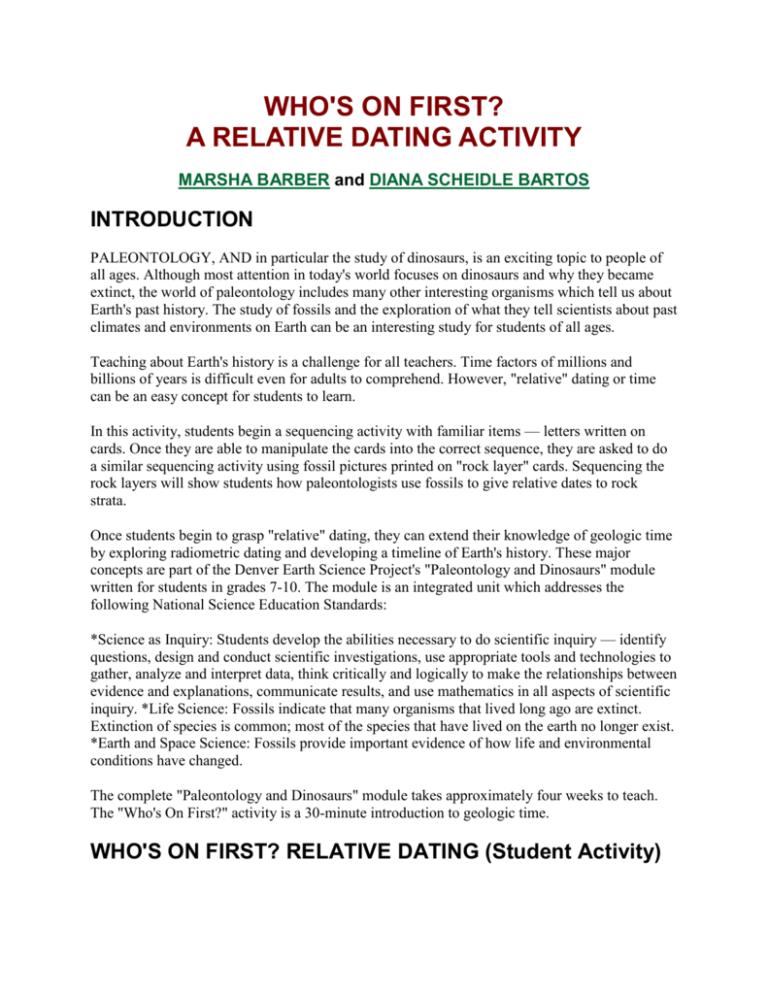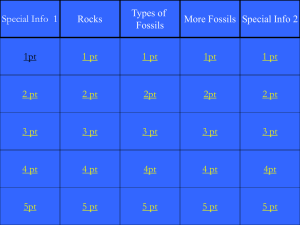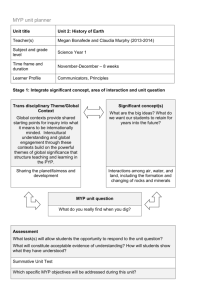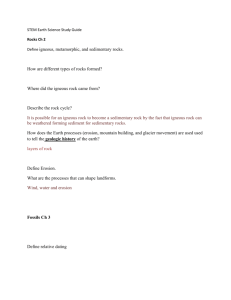Who`s on First: A Relative Dating Activity
advertisement

WHO'S ON FIRST? A RELATIVE DATING ACTIVITY MARSHA BARBER and DIANA SCHEIDLE BARTOS INTRODUCTION PALEONTOLOGY, AND in particular the study of dinosaurs, is an exciting topic to people of all ages. Although most attention in today's world focuses on dinosaurs and why they became extinct, the world of paleontology includes many other interesting organisms which tell us about Earth's past history. The study of fossils and the exploration of what they tell scientists about past climates and environments on Earth can be an interesting study for students of all ages. Teaching about Earth's history is a challenge for all teachers. Time factors of millions and billions of years is difficult even for adults to comprehend. However, "relative" dating or time can be an easy concept for students to learn. In this activity, students begin a sequencing activity with familiar items — letters written on cards. Once they are able to manipulate the cards into the correct sequence, they are asked to do a similar sequencing activity using fossil pictures printed on "rock layer" cards. Sequencing the rock layers will show students how paleontologists use fossils to give relative dates to rock strata. Once students begin to grasp "relative" dating, they can extend their knowledge of geologic time by exploring radiometric dating and developing a timeline of Earth's history. These major concepts are part of the Denver Earth Science Project's "Paleontology and Dinosaurs" module written for students in grades 7-10. The module is an integrated unit which addresses the following National Science Education Standards: *Science as Inquiry: Students develop the abilities necessary to do scientific inquiry — identify questions, design and conduct scientific investigations, use appropriate tools and technologies to gather, analyze and interpret data, think critically and logically to make the relationships between evidence and explanations, communicate results, and use mathematics in all aspects of scientific inquiry. *Life Science: Fossils indicate that many organisms that lived long ago are extinct. Extinction of species is common; most of the species that have lived on the earth no longer exist. *Earth and Space Science: Fossils provide important evidence of how life and environmental conditions have changed. The complete "Paleontology and Dinosaurs" module takes approximately four weeks to teach. The "Who's On First?" activity is a 30-minute introduction to geologic time. WHO'S ON FIRST? RELATIVE DATING (Student Activity) INTRODUCTION Scientists have good evidence that the earth is very old, approximately four and one-half billion years old. Scientific measurements such as radiometric dating use the natural radioactivity of certain elements found in rocks to help determine their age. Scientists also use direct evidence from observations of the rock layers themselves to help determine the relative age of rock layers. Specific rock formations are indicative of a particular type of environment existing when the rock was being formed. For example, most limestones represent marine environments, whereas, sandstones with ripple marks might indicate a shoreline habitat or a riverbed. Return to top The study and comparison of exposed rock layers or strata in various parts of the earth led scientists in the early 19th century to propose that the rock layers could be correlated from place to place. Locally, physical characteristics of rocks can be compared and correlated. On a larger scale, even between continents, fossil evidence can help in correlating rock layers. The Law of Superposition, which states that in an undisturbed horizontal sequence of rocks, the oldest rock layers will be on the bottom, with successively younger rocks on top of these, helps geologists correlate rock layers around the world. This also means that fossils found in the lowest levels in a sequence of layered rocks represent the oldest record of life there. By matching partial sequences, the truly oldest layers with fossils can be worked out. By correlating fossils from various parts of the world, scientists are able to give relative ages to particular strata. This is called relative dating. Relative dating tells scientists if a rock layer is "older" or "younger" than another. This would also mean that fossils found in the deepest layer of rocks in an area would represent the oldest forms of life in that particular rock formation. In reading earth history, these layers would be "read" from bottom to top or oldest to most recent. If certain fossils are typically found only in a particular rock unit and are found in many places worldwide, they may be useful as index or guide fossils in determining the age of undated strata. By using this information from rock formations in various parts of the world and correlating the studies, scientists have been able to establish the geologic time scale. This relative time scale divides the vast amount of earth history into various sections based on geological events (sea encroachments, mountain-building, and depositional events), and notable biological events (appearance, relative abundance, or extinction of certain life forms). Objectives: When you complete this activity, you will be able to: (1) sequence information using items which overlap specific sets; (2) relate sequencing to the Law of Superposition; and (3) show how fossils can be used to give relative dates to rock layers. Materials: two sets of sequence cards in random order (set A: nonsense syllables; set B: sketches of fossils), pencil, paper Procedure Set A: 1) Spread the cards with the nonsense syllables on the table and determine the correct sequence of the eight cards by comparing letters that are common to individual cards and, therefore, overlap. The first card in the sequence has "Card 1, Set A" in the lower left-hand corner and represents the bottom of the sequence. If the letters "T" and "C" represent fossils in the oldest rock layer, they are the oldest fossils, or the first fossils formed in the past for this sequence of rock layers. 2. Now, look for a card that has either a "T" or "C" written on it. Since this card has a common letter with the first card, it must go on top of the "TC" card. The fossils represented by the letters on this card are "younger" than the "T" or "C" fossils on the "TC" card which represents fossils in the oldest rock layer. Sequence the remaining cards by using the same process. When you finish, you should have a vertical stack of cards with the top card representing the youngest fossils of this rock sequence and the "TC" card at the bottom of the stack representing the oldest fossils. Interpretation Questions: 1) After you have arranged the cards in order, write your sequence of letters (using each letter only once) on a separate piece of paper. Starting with the top card, the letters should be in order from youngest to oldest. 2) How do you know that "X" is older than "M"? 3) Explain why "D" in the rock layer represented by DM is the same age as "M." 4) Explain why "D" in the rock layer represented by OXD is older than "D" in the rock layer represented by DM. Return to top Procedure Set B: 1) Carefully examine the second set of cards which have sketches of fossils on them. Each card represents a particular rock layer with a collection of fossils that are found in that particular rock stratum. All of the fossils represented would be found in sedimentary rocks of marine origin. Figure 2-A gives some background information on the individual fossils. 2) The oldest rock layer is marked with the letter "M" in the lower left-hand corner. The letters on the other cards have no significance to the sequencing procedure and should be ignored at this time. Find a rock layer that has at least one of the fossils you found in the oldest rock layer. This rock layer would be younger as indicated by the appearance of new fossils in the rock stratum. Keep in mind that extinction is forever. Once an organism disappears from the sequence it cannot reappear later. Use this information to sequence the cards in a vertical stack of fossils in rock strata. Arrange them from oldest to youngest with the oldest layer on the bottom and the youngest on top. Interpretation Questions: 1) Using the letters printed in the lower left-hand corner of each card, write the sequence of letters from the youngest layer to the oldest layer (i.e., from the top of the vertical stack to the bottom). This will enable your teacher to quickly check whether you have the correct sequence. 2) Which fossil organisms could possibly be used as index fossils? 3) Name three organisms represented that probably could not be used as index fossils and explain why. 4) In what kinds of rocks might you find the fossils from this activity? 5) State the Law of Superposition and explain how this activity illustrates this law. Figure 2-A. Sketches of Marine Fossil Organisms (Not to Scale) NAME: Brachiopod PHYLUM: Brachiopoda DESCRIPTION: "Lampshells"; exclusively marine organisms with soft bodies and bivalve shells; many living species NAME: Trilobite PHYLUM: Arthropoda DESCRIPTION: Three-lobed body; burrowing, crawling, and swimming forms; extinct NAME: Eurypterid PHYLUM: Arthropoda DESCRIPTION: Many were large (a few rare species were 5 feet in length); crawling and swimming forms; extinct NAME: Graptolite PHYLUM: Chordata DESCRIPTION: Primitive form of chordate; floating form with branched stalks; extinct NAME: Horn coral PHYLUM: Coelenterata (Cnidaria) DESCRIPTION: Jellyfish relative with stony (Cnidaria)(calcareous) exoskeleton found in reef environments; extinct NAME: Crinoid PHYLUM: Echinodermata DESCRIPTION: Multibranched relative of starfish; lives attached to the ocean bottom; some living species ("sea lilies") NAME: Placoderm PHYLUM: Vertebrata DESCRIPTION: Primitive armored fish; extinct NAME: Foraminifera (microscopic type) PHYLUM: Protozoa (Sarcodina) DESCRIPTION: Shelled, amoeba-like organism NAME: Gastropod PHYLUM: Mollusca DESCRIPTION: Snails and relatives; many living species NAME: Pelecypod PHYLUM: Mollusca DESCRIPTION: Clams and oysters; many living species NAME: Ammonite PHYLUM: Mollusca DESCRIPTION: Squid-like animal with coiled, chambered shell; related to modern-day Nautilus NAME: Icthyosaur PHYLUM: Vertebrata DESCRIPTION: Carnivore; air-breathing aquatic animal; extinct NAME: Shark's tooth PHYLUM: Vertebrata DESCRIPTION: Cartilage fish; many living species Return to top WHO'S ON FIRST? RELATIVE DATING (Teacher Version) INTRODUCTION Scientists have good evidence that the earth is very old, approximately four and one-half billion years old. Scientific measurements such as radiometric dating use the natural radioactivity of certain elements found in rocks to help determine their age. Scientists also use direct evidence from observations of the rock layers themselves to help determine the relative age of rock layers. Specific rock formations are indicative of a particular type of environment existing when the rock was being formed. For example, most limestones represent marine environments, whereas, sandstones with ripple marks might indicate a shoreline habitat or a riverbed. The study and comparison of exposed rock layers or strata in various parts of the earth led scientists in the early 19th century to propose that the rock layers could be correlated from place to place. Locally, physical characteristics of rocks can be compared and correlated. On a larger scale, even between continents, fossil evidence can help in correlating rock layers. The Law of Superposition, which states that in an undisturbed horizontal sequence of rocks, the oldest rock layers will be on the bottom, with successively younger rocks on top of these, helps geologists correlate rock layers around the world. This also means that fossils found in the lowest levels in a sequence of layered rocks represent the oldest record of life there. By matching partial sequences, the truly oldest layers with fossils can be worked out. By correlating fossils from various parts of the world, scientists are able to give relative ages to particular strata. This is called relative dating. Relative dating tells scientists if a rock layer is "older" or "younger" than another. This would also mean that fossils found in the deepest layer of rocks in an area would represent the oldest forms of life in that particular rock formation. In reading earth history, these layers would be "read" from bottom to top or oldest to most recent. If certain fossils are typically found only in a particular rock unit and are found in many places worldwide, they may be useful as index or guide fossils in determining the age of undated strata. By using this information from rock formations in various parts of the world and correlating the studies, scientists have been able to establish the geologic time scale. This relative time scale divides the vast amount of earth history into various sections based on geological events (sea encroachments, mountain-building, and depositional events), and notable biological events (appearance, relative abundance, or extinction of certain life forms). Objectives: When you complete this activity, you will be able to: (1) sequence information using items which overlap specific sets; (2) relate sequencing to the Law of Superposition; and (3) show how fossils can be used to give relative dates to rock layers. Explore this link for additional information on the topics covered in this lesson: Geologic Time Materials: two sets of sequence cards in random order (set A: nonsense syllables; set B: sketches of fossils), pencil, paper TEACHER SUGGESTIONS The cards in Set A are composed of nonsense syllables. The nonsense syllables or letters sometimes overlap other cards and are being used to introduce the students to the concept of sequencing. The cards should be duplicated, laminated, and cut into sets and randomly mixed when given to the students. It is recommended that students complete Procedure Set A and answer the associated Interpretation Questions correctly before proceeding to Set B. The cards in Set B represent rock layers containing various fossils. For Set B, you may want to color code each organism type (i.e., color the trilobites blue) before you laminate and cut the cards apart. Sequencing the rock layers will show the students how paleontologists use fossils to give relative dates to rock strata. Return to top To enhance this activity, have students match the fossil sketches to real fossils. You may use fossils from the John Hanley Fossil Teaching Set. To request a Fossil Teaching Set, call the Geology Museum at the Colorado School of Mines (303) 273-3815 FREE (303) 273-3815 . The following is a list of fossils in the John Hanley Fossil Teaching Set that may be useful in this activity. Brachiopod VGastropod VI-2 Trilobite VIIIPelecypod VI-1 Graptolite XAmmonite VI3b Corals IIIa, IIIbShark's Tooth XI-1a Crinoids IXa, IxbForaminifera I Figure 2-B illustrates a hypothetical stratigraphic section of rocks which include fossil assemblages represented in Set B. It may be useful to share with students after they have completed Set B and answered the Interpretation Questions. Procedure Set A: 1) Spread the cards with the nonsense syllables on the table and determine the correct sequence of the eight cards by comparing letters that are common to individual cards and, therefore, overlap. The first card in the sequence has "Card 1, Set A" in the lower left-hand corner and represents the bottom of the sequence. If the letters "T" and "C" represent fossils in the oldest rock layer, they are the oldest fossils, or the first fossils formed in the past for this sequence of rock layers. 2) Now, look for a card that has either a "T" or "C" written on it. Since this card has a common letter with the first card, it must go on top of the "TC" card. The fossils represented by the letters on this card are "younger" than the "T" or "C" fossils on the "TC" card which represents fossils in the oldest rock layer. Sequence the remaining cards by using the same process. When you finish, you should have a vertical stack of cards with the top card representing the youngest fossils of this rock sequence and the "TC" card at the bottom of the stack representing the oldest fossils. Interpretation Questions: 1) After you have arranged the cards in order, write your sequence of letters (using each letter only once) on a separate piece of paper. Starting with the top card, the letters should be in order from youngest to oldest. The correct sequence of letters for the cards in Set A from youngest to oldest rock strata is MDXONBUAGCT. Please note that none of the letters in this sequence may be reversed and still be correct. The sequence must be exactly in the order as written. It is not uncommon to have students reverse the M and D for example and begin the sequence with DM because that is the way they are printed on the card. It is good at this time to remind them that these letters represent fossils in a rock layer and that one fossil next to another within a rock layer implies no particular sequencing; they both are approximately the same age as that particular rock layer. The following question may help clarify this point. 2) How do you know that "X" is older than "M"? "X" is older than "M" because it appears in an older rock strata (i.e., the card beneath the "DM" card). "M" is not present in the card below it in the stack and is, therefore, younger. 3) Explain why "D" in the rock layer represented by DM is the same age as "M." Since fossils D and M died and were deposited in the same rock layer, they both are the same age as the rock layer. 4) Explain why "D" in the rock layer represented by OXD is older than "D" in the rock layer represented by DM. Using the Law of Superposition, the rock layer OXD is beneath rock layer DM and, therefore, is older. The fossils within rock layer OXD (i.e., fossils O, X, and D) are older than the fossils in the layer above it (i.e., D and M in rock layer DM). Therefore, D in the rock layer OXD is older than D in the rock layer DM. Procedure Set B: 1) Carefully examine the second set of cards which have sketches of fossils on them. Each card represents a particular rock layer with a collection of fossils that are found in that particular rock stratum. All of the fossils represented would be found in sedimentary rocks of marine origin. Figure 2-A gives some background information on the individual fossils. 2) The oldest rock layer is marked with the letter "M" in the lower left-hand corner. The letters on the other cards have no significance to the sequencing procedure and should be ignored at this time. Find a rock layer that has at least one of the fossils you found in the oldest rock layer. This rock layer would be younger as indicated by the appearance of new fossils in the rock stratum. Keep in mind that extinction is forever. Once an organism disappears from the sequence it cannot reappear later. Use this information to sequence the cards in a vertical stack of fossils in rock strata. Arrange them from oldest to youngest with the oldest layer on the bottom and the youngest on top. Return to top Interpretation Questions: 1) Using the letters printed in the lower left-hand corner of each card, write the sequence of letters from the youngest layer to the oldest layer (i.e., from the top of the vertical stack to the bottom). This will enable your teacher to quickly check whether you have the correct sequence. 2) Which fossil organisms could possibly be used as index fossils? The graptolite, placoderm, ammonite, ichthyosaur, and shark's tooth could possibly be used as index fossils since they are found in only one layer. Technically, however, given only this set of strata, one cannot say that the shark's tooth and ichthyosaur could be used as index fossils because we do not know if they continue in younger rock layers above this set of strata. 3) Name three organisms represented that probably could not be used as index fossils and explain why. The brachiopod, crinoid, eurypterid, foraminifera, gastropod, horn coral, pelecypod, and trilobite could probably not be used as index fossils since they overlap more than one stratum. 4) In what kinds of rocks might you find the fossils from this activity? Marine sedimentary rocks such as limestone, shale, and sandstone might contain fossils similar to those depicted in this activity. 5) State the Law of Superposition and explain how this activity illustrates this law. In a "normal" horizontal sequence of rocks, the oldest rock layers will be on the bottom with successively younger rocks on top. This activity illustrates this law because when the cards are placed in the correct order, the vertical stack shows the oldest fossils in a rock layer in the bottom of the stack and the youngest fossils in rock stratum on the top. Figure 2-B. Stratigraphic Section for Set B Set A Set B









